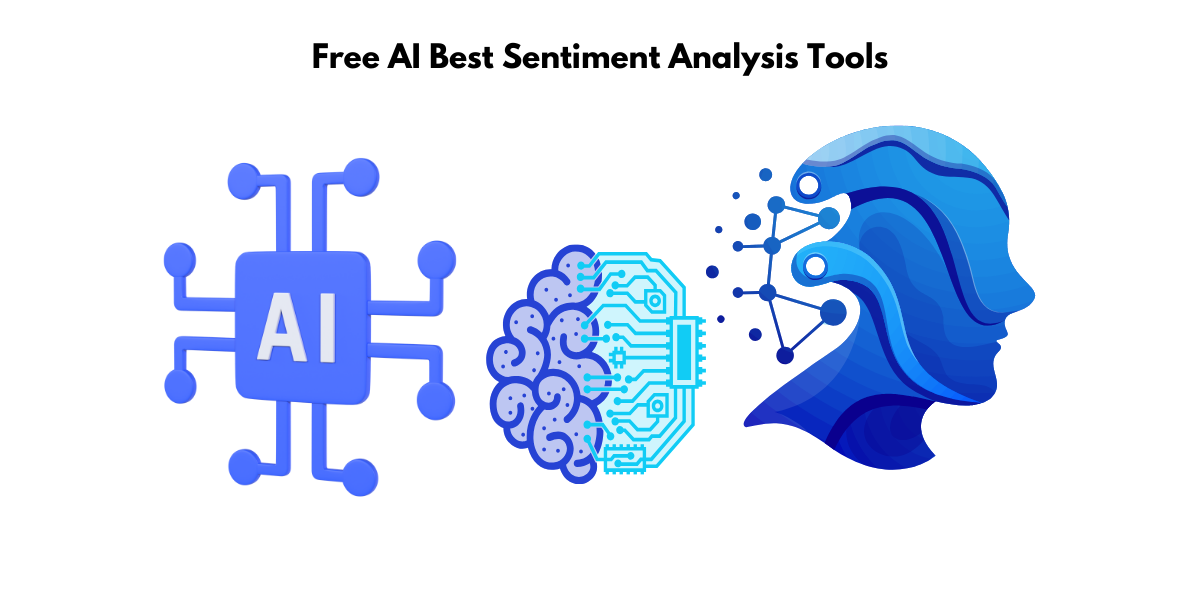Importance of AI Tools
The Rise of Sentiment Analysis Tools
In recent years, sentiment analysis tools have surged in popularity, transforming how businesses interpret customer feedback, social media chatter, and online reviews. These tools use natural language processing (NLP) and machine learning to detect and analyze human emotions from textual data. This ability to gauge consumer sentiment allows companies to adjust strategies promptly and enhance customer experiences. With the evolution of AI, it’s now easier than ever to access robust sentiment analysis capabilities without significant investments.
Benefits of Using Free AI Solutions
Free AI sentiment analysis tools offer numerous advantages, particularly for startups and small businesses. First, they provide cost-effective ways to explore the power of sentiment analysis without the financial commitment required by paid solutions. These tools typically come with a range of features that allow you to test the waters and gauge their impact on your operation.
Additionally, free tools often have a low barrier to entry, making them accessible for users with limited technical expertise. This accessibility enables quick deployment and integration into existing workflows. Moreover, many of these tools offer scalable solutions, allowing you to upgrade to advanced features as your needs grow.
Another key benefit is the opportunity to experiment with different tools to find the one that best meets your business needs without any upfront investment. Free access also allows you to gather preliminary data and insights that can inform strategy and justify the need for a dedicated, possibly paid tool in the future.
Moreover, these tools often come with robust support communities, offering you the chance to learn from other users’ experiences.

Top Free AI Sentiment Analysis Tools
Talkwalker: A Leader in Consumer Intelligence
Talkwalker stands out as a leader in consumer intelligence due to its comprehensive analytics platform that specializes in real-time sentiment analysis. As a free tool, it provides accessible insights for businesses aiming to understand their audience better. With its powerful AI-driven capabilities, Talkwalker assesses sentiment across multiple channels, including social media, blogs, and forums. This wide scope helps in capturing a holistic view of consumer sentiments.
Top 5 Features:
- Multilingual Analysis: Offers sentiment detection in multiple languages for global reach.
- Visual Insights: Includes image recognition to assess sentiments in visual content.
- Customizable Dashboards: Personalizable insights tailored to specific business needs.
- Real-Time Alerts: Notifies users instantly on significant sentiment changes.
- Trend Prediction: Uses AI to predict future consumer trends.
Benefits:
- Enhances understanding of customer feedback.
- Identifies potential crises early through real-time alerts.
- Facilitates data-driven decision-making with actionable insights.
- Supports brand reputation management effectively.
- Enables customization to align with unique business goals.
Cons:
- May have limitations in the volume of data analyzed in the free version.
- Requires some initial setup for customized dashboard settings.
Best For: Talkwalker is best suited for small to mid-sized companies that seek extensive consumer insights without the hefty cost. It’s ideal for teams looking to enhance their understanding of market trends and improve brand strategy effectively.

MonkeyLearn: Customizable and User-Friendly
MonkeyLearn is renowned for its customizable and user-friendly platform, making it perfect for those who want to tailor sentiment analysis to their specific needs. It provides an intuitive interface alongside powerful AI tools that allow users to create personalized models for analyzing texts. This level of customization ensures that you can focus on the sentiments most relevant to your business objectives.
Top 5 Features:
- Drag-and-Drop Interface: Facilitates easy model creation without coding expertise.
- Pre-trained Models: Offers ready-to-use models for quick deployment.
- API Integration: Seamlessly connects with other applications and platforms.
- Real-Time Analysis: Provides instant sentiment feedback from data inputs.
- Scalable Solutions: Grows with your business needs, from free to paid plans.
Benefits:
- Offers a hands-on approach to customizing sentiment analysis.
- Reduces time to implementation with its pre-trained models.
- Enhances productivity through smooth integrations.
- Provides quick insights with real-time sentiment analysis.
- Scales efficiently to accommodate increasing data needs.
Cons:
- Feature limitations in the free version may necessitate upgrading.
- Requires some initial learning to maximize model customization.
Best For: MonkeyLearn is ideal for small business teams and developers looking for highly customizable sentiment analysis solutions without delving into complex coding. It’s best for users who want to fine-tune their models to match specific business requirements.
Brand24: Real-Time Social Insights
Brand24 excels at delivering real-time social insights, helping brands manage and understand their online presence effectively. As a free tool, it offers robust capabilities for tracking and analyzing mentions across various social platforms, providing a pulse on public sentiment in real-time. It’s particularly valuable for businesses looking to enhance their social media strategies through immediate feedback loops.
Top 5 Features:
- Mention Tracking: Monitors brand mentions and discussions across social media.
- Sentiment Analysis: Evaluates emotional tone in online mentions for brand perception.
- Influencer Identification: Identifies key influencers within your industry.
- Hashtag Analysis: Tracks the performance and reach of specific hashtags.
- Detailed Reporting: Offers comprehensive reports for data-driven decision making.
Benefits:
- Provides real-time feedback to quickly adapt strategies.
- Enhances reputation management by identifying discussion hotspots.
- Assists in efficiently managing social media efforts.
- Facilitates influencer outreach through precise identification.
- Offers data that supports evidence-based marketing tactics.
Cons:
- The free version may come with restrictions on data access.
- Initial setup can be time-consuming for extensive tracking.
Best For: Brand24 is best suited for social media managers and marketing teams aiming to capitalize on real-time insights for enhanced brand engagement and reputation management. It’s ideal for those who need immediate updates on public opinion and social media dynamics.

Lexalytics: Understanding Context with AI
Lexalytics shines in its ability to understand context using sophisticated AI technologies. This tool is particularly adept at parsing complex texts to determine nuanced sentiments, making it essential for businesses that deal with intricate or industry-specific language. By leveraging its context-aware AI, Lexalytics provides deeper insights beyond mere positive, negative, or neutral categorizations.
Top 5 Features:
- Contextual Understanding: Analyzes subtle contextual cues for precise sentiment.
- Industry-Specific Models: Offers tailored approaches for different sectors.
- Entity Recognition: Identifies and categorizes entities within text data.
- Semantic Analysis: Uncovers hidden meanings and relationships in text.
- Multilingual Support: Provides analysis in multiple languages for global insights.
Benefits:
- Delivers deeper insights by capturing sentiment nuances.
- Meets diverse industry needs with specialized models.
- Enhances understanding of complex data through semantic analysis.
- Supports global operations with multilingual capabilities.
- Improves decision-making with accurate sentiment evaluations.
Cons:
- Advanced features may require a learning curve for new users.
- The free version may not include all specialized models.
Best For: Lexalytics is best for large enterprises and industries dealing with complex and technical content, seeking to gain a richer understanding of customer sentiments and internal data. It’s ideal for businesses that require precise, detailed sentiment analysis across large or intricate datasets.

How to Choose the Right Tool for Your Needs
Key Features to Consider
When choosing a sentiment analysis tool, it’s crucial to focus on key features that align with your specific needs. Here are some core features to consider:
- Accuracy: Look for tools with proven accuracy rates to ensure reliable sentiment detection. High precision in analysis is vital for informed decision-making.
- Customization Options: Opt for solutions that offer customizable models. This allows you to tailor the tool to your business’s unique requirements, focusing on the sentiments most relevant to your goals.
- Integration Capabilities: Ensure the tool can seamlessly integrate with other software and platforms you use, such as CRM systems, social media platforms, and data analytics tools.
- User Interface: A user-friendly interface can significantly reduce the time spent learning and using the tool effectively. Prioritize platforms with intuitive dashboards and easy navigation.
- Real-time Analysis: Real-time data processing is valuable for businesses that need to react quickly to changes in consumer sentiment. This feature facilitates prompt strategic adjustments.
By focusing on these features, you can choose a tool that not only fits your present needs but also scales with your business as it grows.
Evaluating Tool Accuracy and Reliability
Assessing the accuracy and reliability of sentiment analysis tools is vital for obtaining valuable insights you can trust. Here are a few strategies to evaluate these aspects effectively:
- Cross-Validation Results: Evaluate the tool’s accuracy by examining cross-validation results provided by the developers. High cross-validation accuracy indicates that the tool functions well across different datasets.
- User Reviews and Case Studies: Look for user reviews and case studies that specifically mention the tool’s accuracy in real-world applications. Consistent positive feedback can be a good indicator of reliability.
- Benchmark Testing: See if the tool has been tested against industry benchmarks. Benchmark tests compare performance under standardized conditions, offering a better grasp of reliability.
- Error Rate Analysis: Check the error rates for false positives and negatives in sentiment analysis results. Lower error rates mean the tool is more precise in sentiment detection.
- Trial Period Use: Take advantage of any free trials the tool offers. This period allows you to test the tool’s accuracy and provides firsthand experience of its performance with your data.
By comprehensively evaluating these factors, you will have a clearer picture of which sentiment analysis tool will provide accurate, reliable insights over time.
Comparing User Experiences and Interface
When selecting a sentiment analysis tool, understanding user experiences and assessing the interface are crucial elements of the decision-making process. A positive user experience can lead to greater efficiency and satisfaction, while a well-designed interface can enhance usability and functionality. Here are key points to consider:
- Ease of Use: Evaluate whether users find the tool intuitive and straightforward. Tools with a high ease-of-use rating often have simple navigation and clear instructions, reducing the learning curve.
- Customization and Flexibility: Look for reviews that reflect how easily users can customize the tool to fit their specific needs. A flexible tool often allows users to modify dashboards and reports according to their preferences.
- Visual Design: A clear and aesthetically pleasing interface can aid comprehension and speed up tasks. Tools that offer informative and well-organized visualizations help streamline data analysis.
- Support and Resources: Consider the availability of support services. Tools that come with ample resources, such as tutorials, forums, and customer service, tend to facilitate better user experiences.
- User Feedback: Compare feedback on forums or review sites to understand common user concerns or praised features. Consistent themes in user reviews can give insights into the experience you might have.
By focusing on these areas, you can select a sentiment analysis tool that not only meets your technical needs but also enhances user satisfaction through an engaging interface and a positive overall experience.
Implementation Tips for New Users
Integrating Tools into Existing Workflows
Integrating sentiment analysis tools into your existing workflows can significantly enhance your data analysis capabilities without disrupting current processes. Here are the steps to seamlessly incorporate these tools:
- Audit Current Workflows: Start by reviewing your current workflows to identify where sentiment analysis can add the most value, such as in customer feedback loops or social media monitoring.
- Select Integration-Friendly Tools: Choose tools with robust API or plugin options that can seamlessly integrate with your existing platforms, such as CRM systems or analytics dashboards.
- Pilot Testing: Implement a pilot program to test the tool within a small scope. This allows you to identify any integration challenges and gather feedback without affecting broader operations.
- Automation Opportunities: Look for automation features within the tool that reduce manual data input and streamline repetitive tasks, which can optimize your workflows further.
- Training and Support: Ensure your team is well-trained on the tool and is aware of how it fits into existing workflows. Leverage available training resources and customer support to ease the transition.
- Monitor and Adjust: After full implementation, continuously monitor the tool’s integration and make necessary adjustments to improve alignment with your workflow goals.
By approaching integration thoughtfully, you can maximize the benefits of sentiment analysis tools while maintaining the efficiency of your current processes.
Leveraging Data for Strategic Decisions
Leveraging sentiment analysis data can transform strategic decision-making by providing insights grounded in customer feedback and market trends. Here’s how you can harness this data effectively:
- Identify Trends and Patterns: Use sentiment analysis to spot emerging trends and patterns in customer opinions. This can guide product development, marketing strategies, and brand positioning.
- Enhance Customer Experience: Analyze sentiment data to understand customer pain points and preferences. Tailor your services or products to better meet customer expectations, thus enhancing overall satisfaction.
- Real-Time Decision Making: With real-time sentiment insights, you can quickly adjust campaigns or strategies in response to public perception or market changes.
- Competitive Advantage: Evaluate competitor sentiment to identify areas where your brand can differentiate itself and fill market gaps.
- Informed Resource Allocation: Use the insights gathered to make informed decisions on where to allocate resources, such as focus on high-performing campaigns or improvement areas needing attention.
- Data-Driven Leadership: Empower leadership with comprehensive sentiment data to support strategic planning and risk management.
By integrating sentiment analysis findings into your strategic framework, you ensure that your decisions are not just data-informed but also aligned with the needs and sentiments of your audience.

Avoiding Common Pitfalls
While using sentiment analysis tools offers numerous advantages, being aware of potential pitfalls can help you optimize outcomes and avoid setbacks. Here are common challenges and ways to mitigate them:
- Misinterpretation of Data: Sentiment scores can sometimes be ambiguous. Ensure that you contextualize basic positive or negative readings by looking at the qualitative data alongside the quantitative analysis.
- Overreliance on Automation: While automation streamlines processes, human oversight is vital for nuanced understanding. Combine automated results with expert analysis for more accurate insights.
- Ignoring Edge Cases: Sentiment analysis tools might struggle with sarcasm, slang, or industry-specific jargon. Train models regularly and supplement with manual checks to address edge cases effectively.
- Data Privacy Concerns: Always ensure compliance with data protection regulations like GDPR. Use tools that offer robust data privacy features to safeguard customer information.
- Overlooking Continuous Learning: Sentiment trends can evolve over time. Regularly update the analysis models for them to learn and adapt to language changes and new data patterns.
By staying mindful of these pitfalls, you can ensure that your sentiment analysis efforts yield reliable and actionable insights.
FAQs
What is the primary use of sentiment analysis tools?
The primary use of sentiment analysis tools is to interpret and evaluate public opinion and emotions expressed in text data. These tools help businesses understand customer sentiments, enhance customer service, improve marketing strategies, and manage brand reputation by identifying trends and patterns in consumer feedback.
Are free tools as effective as paid versions?
Free sentiment analysis tools can be effective for basic needs but often come with limitations such as data volume restrictions or fewer advanced features. They are suitable for initial exploration or small-scale projects, while paid versions typically offer more comprehensive capabilities, higher accuracy, and better support for extensive business applications.
How do AI-powered tools enhance sentiment analysis?
AI-powered tools enhance sentiment analysis by utilizing natural language processing and machine learning to more accurately interpret complex language, detect nuances, and analyze large datasets swiftly. These technologies improve the accuracy and depth of insights, allowing for more context-aware sentiment evaluations and real-time analysis of evolving trends.

